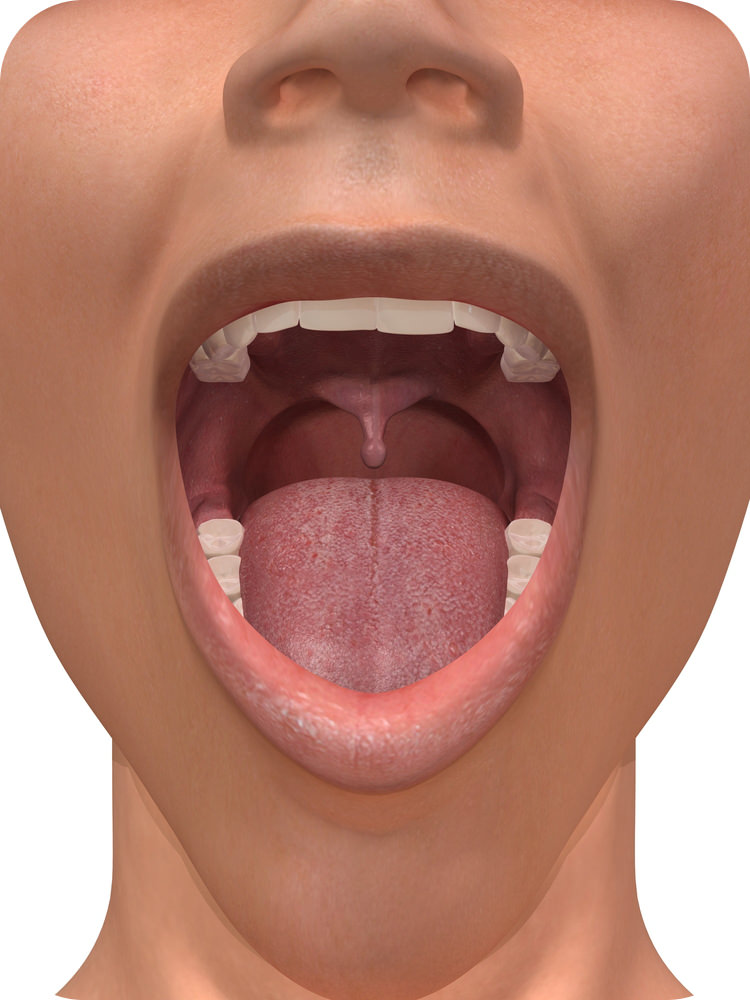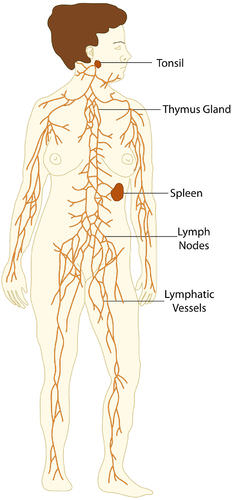11.22: Lymphatic System
- Page ID
- 14322

Do you still have your tonsils?
Many people have their tonsils removed because they can hold on to germs that cause throat infections. Although sometimes they can do more harm than good, tonsils are there to help you. They trap pathogens so that they can be destroyed before they enter farther into your body.
The Lymphatic System and the Immune Response
If pathogens get through the body’s first two lines of defense, a third line of defense takes over. This third line of defense involves the immune system. It is called an immune response, and is a specific type of response. The immune system has a special response for each type of pathogen.
The immune system (Figure below) is also part of the lymphatic system—named for lymphocytes, which are the type of white blood cells involved in an immune response. They include several lymph organs, lymph vessels, lymph, and lymph nodes.

Lymph Organs
The lymph organs are the red bone marrow, tonsils, spleen, and thymus gland. They are described below (Figure below). The thymus gland produces T cells or T-lymphocytes and the spleen and tonsils help in fighting infections. The spleen’s main function is to filter the blood, removing unwanted red blood cells. The spleen also detects viruses and bacteria and triggers the release of pathogen fighting cells.

Lymph and Lymph Vessels
Lymph vessels make up a circulatory system that is similar to the cardiovascular system, which you can read about in a previous concept. Lymph vessels are like blood vessels, except they move lymph instead of blood. Lymph is a yellowish liquid that leaks out of tiny blood vessels into spaces between cells in tissues. Where there is more inflammation, there is usually more lymph in tissues. This lymph may contain many pathogens.
The lymph that collects in tissues slowly passes into tiny lymph vessels. It then travels from smaller to larger lymph vessels. Lymph is not pumped through lymph vessels like blood is pumped through blood vessels by the heart. Instead, muscles around the lymph vessels contract and squeeze the lymph through the vessels. The lymph vessels also contract to help move the lymph along. The lymph finally reaches the main lymph vessels in the chest. Here, the lymph drains into two large veins. This is how the lymph returns to the bloodstream.
Before lymph reaches the bloodstream, pathogens are removed from it at lymph nodes. Lymph nodes are small, oval structures located along the lymph vessels. They act like filters. Any pathogens filtered out of the lymph at lymph nodes are destroyed by lymphocytes in the nodes.
Lymphocytes
Lymphocytes (Figure below), a type of white blood cell, are the key cells of an immune response. There are trillions of lymphocytes in the human body. They make up about one quarter of all white blood cells. Usually, fewer than half of the body’s lymphocytes are in the blood. The rest are in the lymph, lymph nodes, and lymph organs.

There are two main types of lymphocytes:
- B cells.
- T cells.
Both types of lymphocytes are produced in the red bone marrow. They are named for the sites where they grow larger. The "B" in B cells stands for “bone.” B cells grow larger in red bone marrow. The "T" in T cells stands for “thymus.” T cells mature in the thymus gland.
B and T cells must be “switched on” in order to fight a specific pathogen. Once this happens, they produce an army of cells ready to fight that particular pathogen. How can B and T cells recognize specific pathogens? Pathogens have proteins, often located on their cell surface. These proteins are called antigens. An antigen is any protein that causes an immune response, because it is unlike any protein that the body makes. Antigens are found on bacteria, viruses, and other pathogens. Your body sees these as foreign, meaning they do not belong in your body.
Summary
- The immune system includes lymph organs, lymph vessels, lymph, and lymph nodes.
- Lymph organs include the red bone marrow, thymus gland, spleen, and tonsils.
- Lymphocytes, including B cells and T cells, are key cells in the immune response.
Explore More
Use the resource below to answer the questions that follow.
- Lymphatic System: Facts, Functions & Diseases at http://www.livescience.com/26983-lymphatic-system.html
- What is the main function of the lymphatic system?
- What are the tonsils?
- How do the lymph nodes act in the lymphatic system?
Review
- What are three examples of lymph organs?
- What is the role of the tonsils?
- What are lymph nodes? What is their function?
- Distinguish between B and T lymphocytes.

